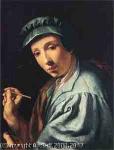Alessandro Allori
Alessandro Allori
Style: Renaissance;
Place: Florence
Born: 1535
Death: 1607
Biography:
Artistic Style and Influences
Allori's work is often described as derivative, with some critics claiming that he illustrates the ideal of Maniera, where art is generated from pre-existing art. His style is marked by a polish of figures with an unnatural marble-like form, giving his paintings a two-dimensional, statue-like quality. This can be seen in his collaboration with Giovanni Maria Butteri and his main pupil, Giovanni Bizzelli. Other notable pupils include Cristoforo del Altissimo, Cesare Dandini, Aurelio Lomi, John Mosnier, Alessandro Pieroni, Giovanni Battista Vanni, and Monanni. Notable Works and Legacy
Allori's work can be found in various museums, including the Gemäldegalerie in Berlin. In 2006, a painting by Allori was returned to the Gemäldegalerie by BBC foreign correspondent Sir Charles Wheeler, who had been given it in Germany in 1952. The work is possibly a portrait of Eleonora (Dianora) di Toledo de' Medici, niece of Eleonora di Toledo. Allori's legacy extends to his son, Cristofano Allori, who also became a painter.
Conclusion
Alessandro Allori was a significant contributor to the Mannerist movement, and his work continues to be studied and admired by art enthusiasts. His unique style, characterized by an unnatural marble-like form and a focus on cold statuary, sets him apart from other artists of his time. Through his collaborations with other notable artists and his contributions to the art world, Allori has left a lasting legacy that can be seen in various museums and collections around the world. For more information on Alessandro Allori and his work, visit https://Wikioo.org/@/AlessandroAllori or explore the Wikipedia page for a comprehensive biography.
Wikipedia link: Click Here














